Abstract
To determine whether hydralazine, a systemic vasodilator, exerted a similar effect on the pulmonary circulation, we studied the circulatory changes in dogs during three interventions: (a) the control state during room air ventilation; (b) during continuous hypoxic ventilation with 10% oxygen, and maintaining continuous hypoxic ventilation; and (c) after 1 mg/kg hydralazine intravenously.
Ventilation with 10% oxygen caused the mean pulmonary artery pressure to increase from 10±1.2 to 23±2.4 mm Hg (P < 0.01) and the pulmonary arteriolar resistance to increase from 1.51±0.19 to 5.87±1.10 U (P < 0.01). Hydralazine significantly lowered the pulmonary artery pressure (23.0±2.4 to 14.3±1.5 mm Hg, P < 0.01) and the pulmonary arteriolar resistance (5.87±1.10 to 2.87±0.52 U, P < 0.01). Femoral artery pressure, pulmonary artery wedge pressure, heart rate, and cardiac output remained unchanged throughout.
To ascertain the contribution of the prostaglandin system to the pulmonary vasodilator effects of hydralazine, we pretreated a group of dogs with the prostaglandin synthetase inhibitor, indomethacin, 5 mg/kg s.c., twice daily for 2 d. These animals then underwent identical studies.
The pretreated dogs had comparable base-line and hypoxia hemodynamic data. However, hydralazine had no effect on pulmonary artery pressure (23.3±1.6 vs. 21.7±2.3 mm Hg, NS) or pulmonary arteriolar resistance (8.03±1.09 vs. 7.14±1.42, NS) during continuous hypoxic ventilation in the indomethacin-pretreated group. Pretreatment with indomethacin did not, however, block the pulmonary vasodilator effects of intravenous prostacyclin (PGI2). Pretreatment with meclofenamate, a cyclo-oxygenase inhibitor structurally unrelated to indomethacin, also blocked the effects of hydralazine during hypoxic ventilation. These data suggest that hydralazine exerts a pulmonary vasodilatory effect during hypoxia-induced pulmonary vasoconstriction, and that this vasodilator effect may be mediated by prostaglandins.
Full text
PDF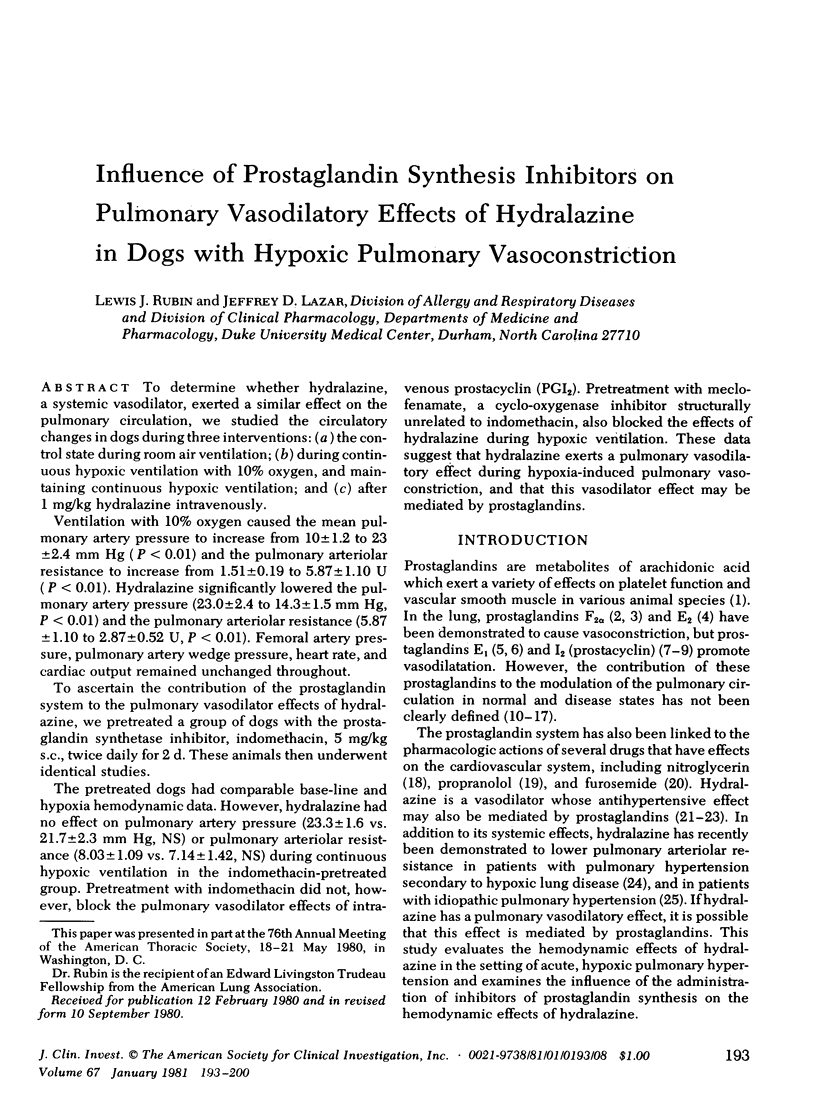
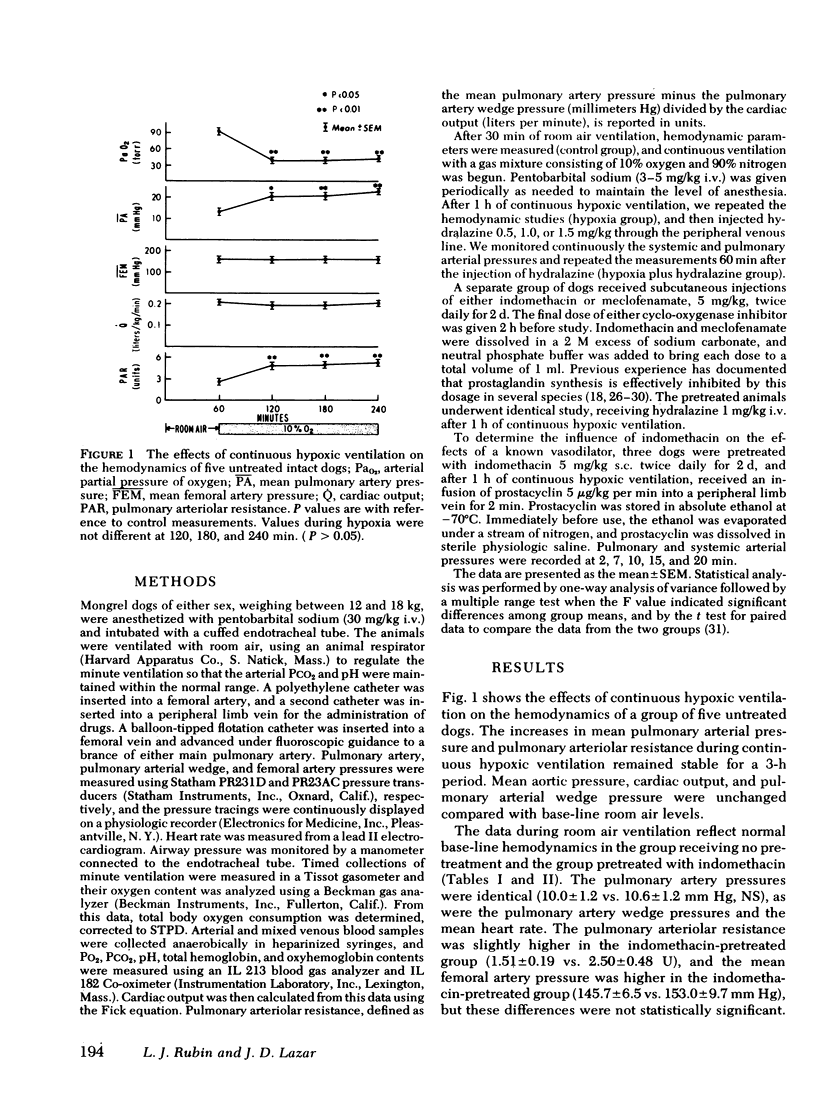
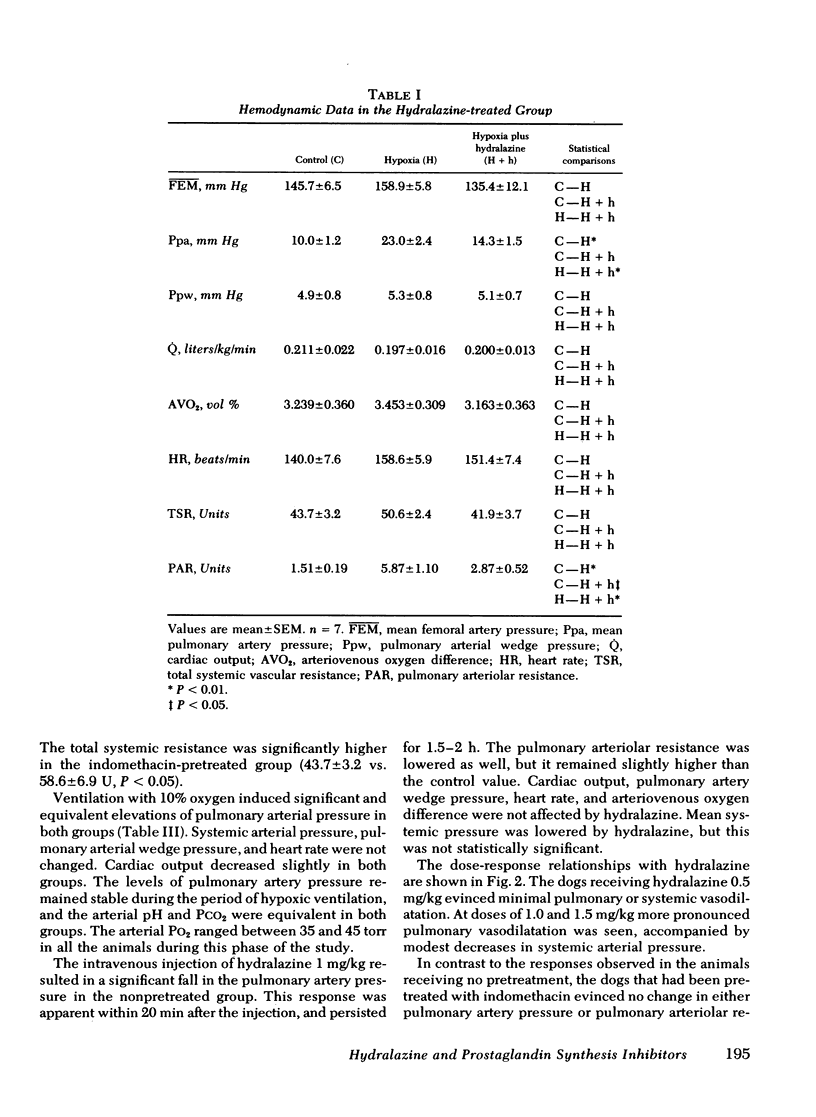
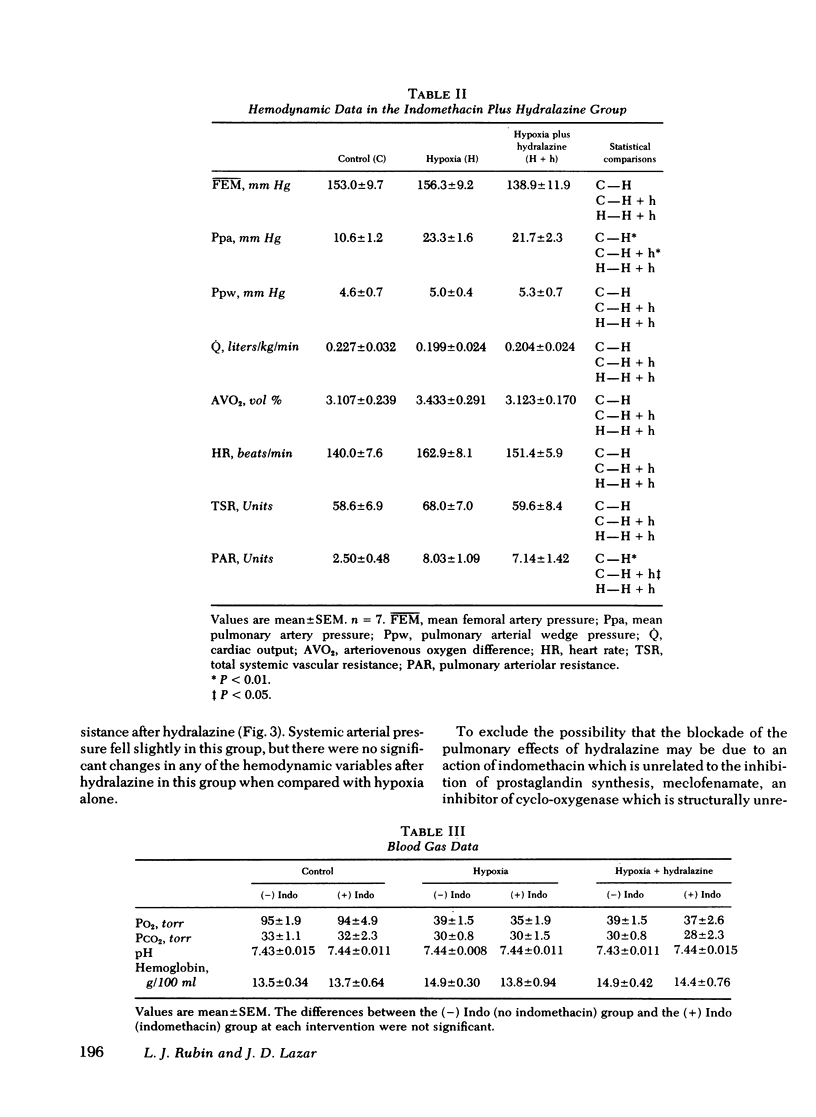
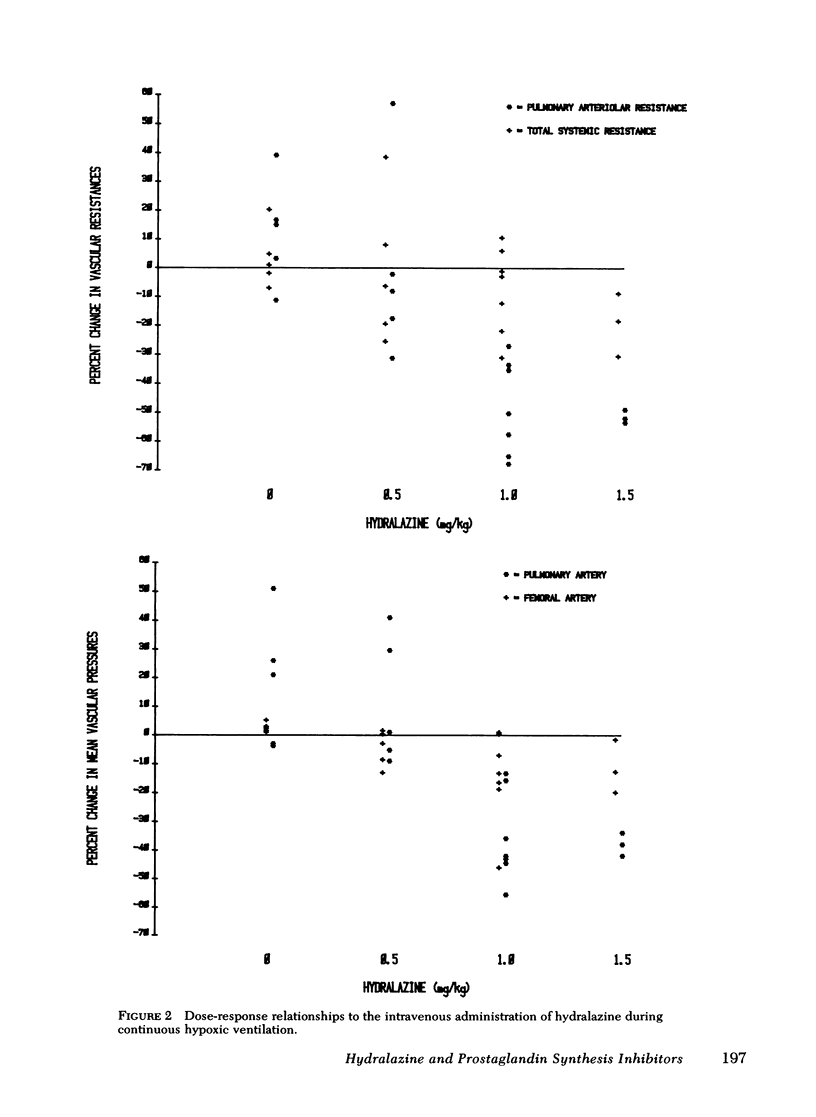
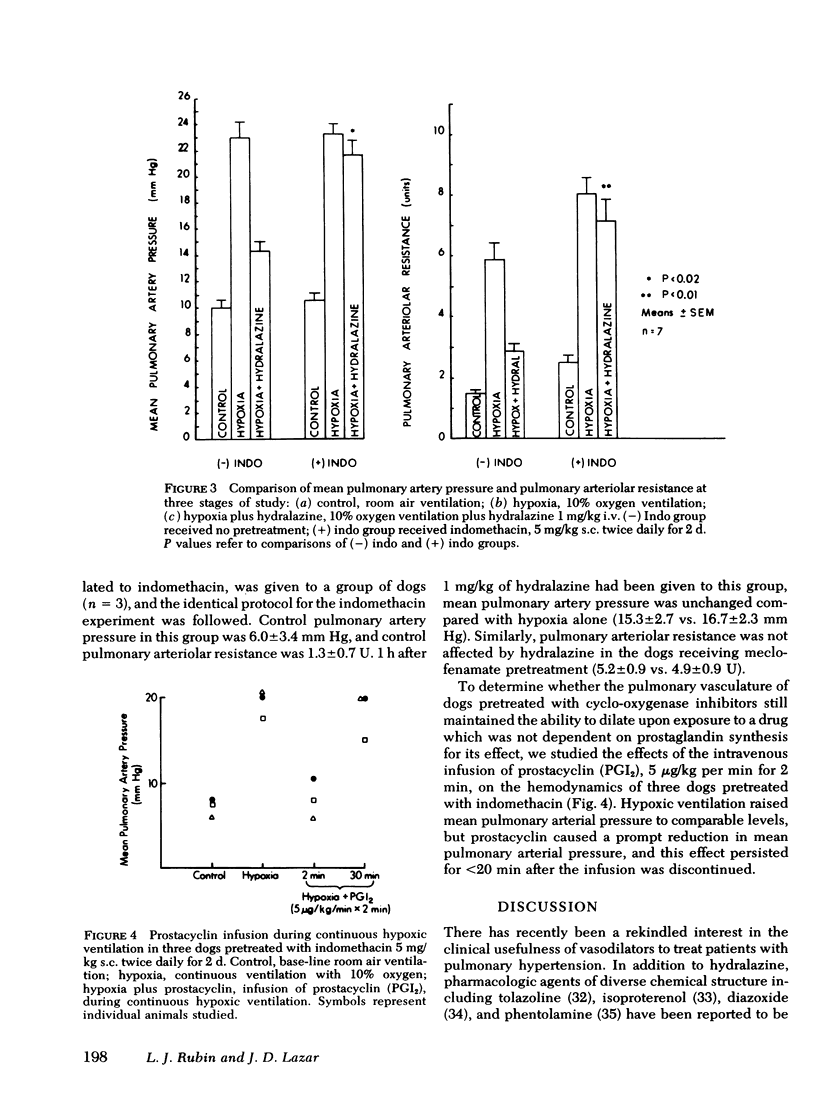
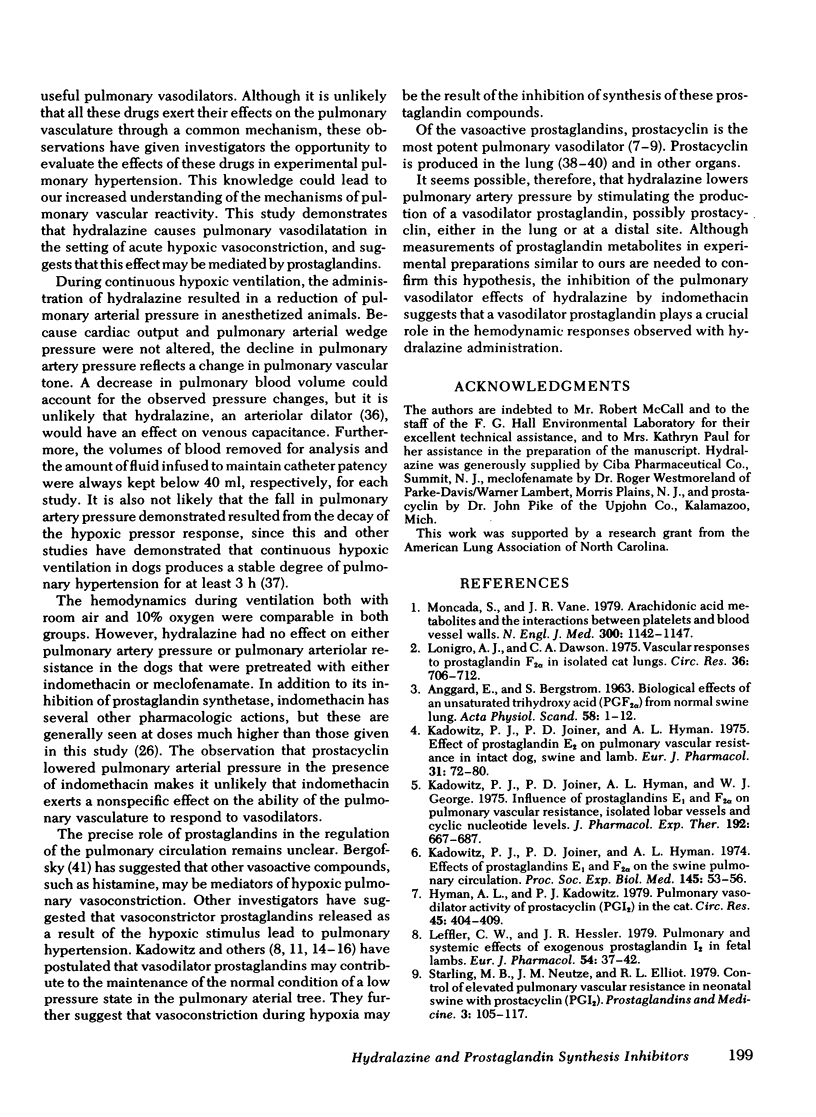
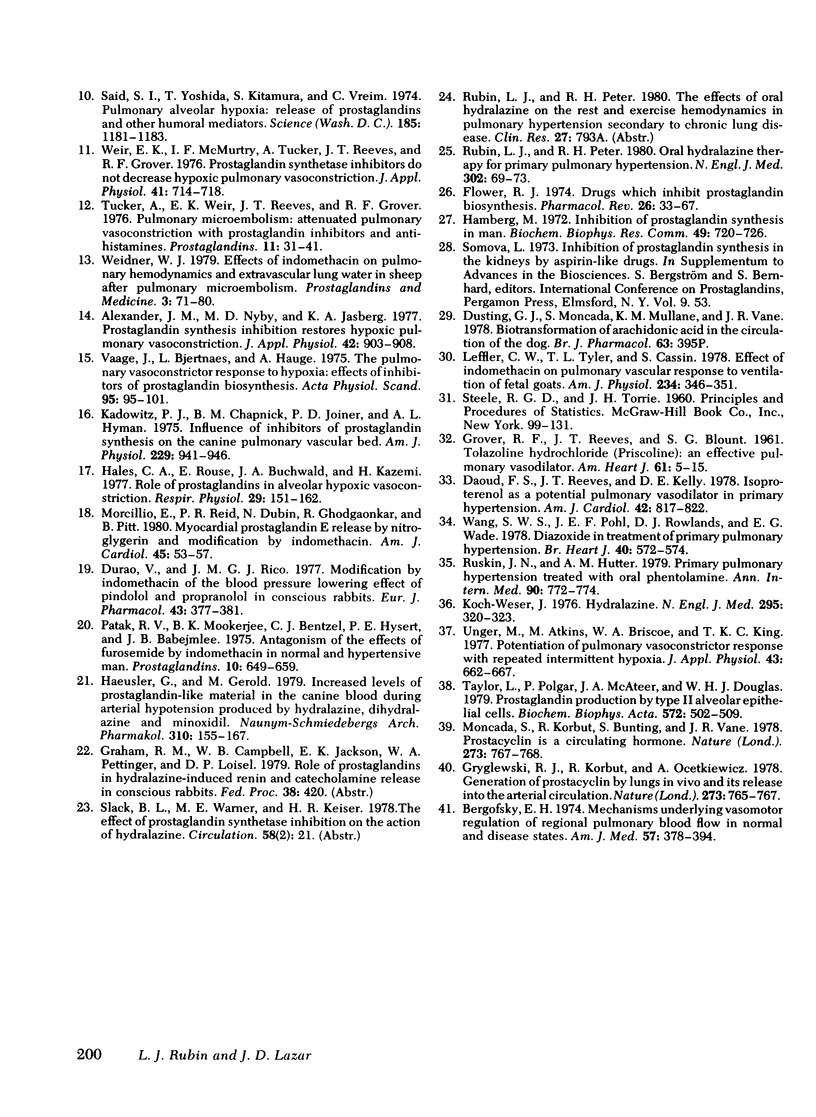
Selected References
These references are in PubMed. This may not be the complete list of references from this article.
- ANGGARD E., BERGSTROM S. Biological effects of an unsaturated trihydroxy acid (PGF2alfa) from normal swine lung. Acta Physiol Scand. 1963 May;58:1–12. doi: 10.1111/j.1748-1716.1963.tb02622.x. [DOI] [PubMed] [Google Scholar]
- Alexander J. M., Nyby M. D., Jasberg K. A. Prostaglandin synthesis inhibition restores hypoxic pulmonary vasoconstriction. J Appl Physiol Respir Environ Exerc Physiol. 1977 Jun;42(6):903–908. doi: 10.1152/jappl.1977.42.6.903. [DOI] [PubMed] [Google Scholar]
- Bergofsky E. H. Mechanisms underlying vasomotor regulation of regional pulmonary blood flow in normal and disease states. Am J Med. 1974 Sep;57(3):378–394. doi: 10.1016/0002-9343(74)90133-8. [DOI] [PubMed] [Google Scholar]
- Daoud F. S., Reeves J. T., Kelly D. B. Isoproterenol as a potential pulmonary vasodilator in primary pulmonary hypertension. Am J Cardiol. 1978 Nov;42(5):817–822. doi: 10.1016/0002-9149(78)90102-9. [DOI] [PubMed] [Google Scholar]
- Durão V., Rico J. M. Modification by indomethacin of the blood pressure lowering effect of pindolol and propranolol in conscious rabbits. Eur J Pharmacol. 1977 Jun 15;43(4):377–381. doi: 10.1016/0014-2999(77)90044-9. [DOI] [PubMed] [Google Scholar]
- Flower R. J. Drugs which inhibit prostaglandin biosynthesis. Pharmacol Rev. 1974 Mar;26(1):33–67. [PubMed] [Google Scholar]
- GROVER R. F., REEVES J. T., BLOUNT S. G., Jr Tolazoline hydrochloride (Priscoline): an effective pulmonary vasodilator. Am Heart J. 1961 Jan;61:5–15. doi: 10.1016/0002-8703(61)90510-5. [DOI] [PubMed] [Google Scholar]
- Gryglewski R. J., Korbut R., Ocetkiewicz A. Generation of prostacyclin by lungs in vivo and its release into the arterial circulation. Nature. 1978 Jun 29;273(5665):765–767. doi: 10.1038/273765a0. [DOI] [PubMed] [Google Scholar]
- Haeusler G., Gerold M. Increased levels of prostaglandin-like material in the canine blood during arterial hypotension produced by hydralazine, dihydralazine and minoxidil. Naunyn Schmiedebergs Arch Pharmacol. 1979 Dec;310(2):155–167. doi: 10.1007/BF00500280. [DOI] [PubMed] [Google Scholar]
- Hales C. A., Rouse E., Buchwald I. A., Kazemi H. Role of prostaglandins in alveolar hypoxic vasoconstriction. Respir Physiol. 1977 Apr;29(2):151–162. doi: 10.1016/0034-5687(77)90088-3. [DOI] [PubMed] [Google Scholar]
- Hamberg M. Inhibition of prostaglandin synthesis in man. Biochem Biophys Res Commun. 1972 Nov 1;49(3):720–726. doi: 10.1016/0006-291x(72)90470-6. [DOI] [PubMed] [Google Scholar]
- Hyman A. L., Kadowitz P. J. Pulmonary vasodilator activity of prostacyclin (PGI2) in the cat. Circ Res. 1979 Sep;45(3):404–409. doi: 10.1161/01.res.45.3.404. [DOI] [PubMed] [Google Scholar]
- Kadowitz P. J., Chapnick B. M., Joiner P. D., Hyman A. L. Influence of inhibitors of prostaglandin synthesis on the canine pulmonary vascular bed. Am J Physiol. 1975 Oct;229(4):941–946. doi: 10.1152/ajplegacy.1975.229.4.941. [DOI] [PubMed] [Google Scholar]
- Kadowitz P. J., Joiner P. D., Hyman A. L. Effect of prostaglandin E2 on pulmonary vascular resistance in intact dog, swine and lamb. Eur J Pharmacol. 1975 Mar;31(1):72–80. doi: 10.1016/0014-2999(75)90080-1. [DOI] [PubMed] [Google Scholar]
- Kadowitz P. J., Joiner P. D., Hyman A. L. Effects of prostaglandins E1 and F2a on the swine pulmonary circulation. Proc Soc Exp Biol Med. 1974 Jan;145(1):53–58. doi: 10.3181/00379727-145-37746. [DOI] [PubMed] [Google Scholar]
- Kadowitz P. J., Joiner P. D., Hyman A. L., George W. J. Influence of prostaglandins E1 and F2alpha on pulmonary vascular resistance, isolated lobar vessels and cyclic nucleotide levels. J Pharmacol Exp Ther. 1975 Mar;192(3):677–687. [PubMed] [Google Scholar]
- Koch-Weser J. Medical intelligence drug therapy. N Engl J Med. 1976 Aug 5;295(6):320–323. doi: 10.1056/NEJM197608052950606. [DOI] [PubMed] [Google Scholar]
- Leffler C. W., Hessler J. R. Pulmonary and systemic vascular effects of exogenous prostaglandin I2 in fetal lambs. Eur J Pharmacol. 1979 Feb 15;54(1-2):37–42. doi: 10.1016/0014-2999(79)90405-9. [DOI] [PubMed] [Google Scholar]
- Lonigro A. J., Dawson C. A. Vascular responses to prostaglandin F 2 alpha in isolated cat lungs. Circ Res. 1975 Jun;36(6):706–712. doi: 10.1161/01.res.36.6.706. [DOI] [PubMed] [Google Scholar]
- Moncada S., Korbut R., Bunting S., Vane J. R. Prostacyclin is a circulating hormone. Nature. 1978 Jun 29;273(5665):767–768. doi: 10.1038/273767a0. [DOI] [PubMed] [Google Scholar]
- Moncada S., Vane J. R. Arachidonic acid metabolites and the interactions between platelets and blood-vessel walls. N Engl J Med. 1979 May 17;300(20):1142–1147. doi: 10.1056/NEJM197905173002006. [DOI] [PubMed] [Google Scholar]
- Morcillio E., Reid P. R., Dubin N., Ghodgaonkar R., Pitt B. Myocardial prostaglandin E release by nitroglycerin and modification by indomethacin. Am J Cardiol. 1980 Jan;45(1):53–57. doi: 10.1016/0002-9149(80)90219-2. [DOI] [PubMed] [Google Scholar]
- Patak R. V., Mookerjee B. K., Bentzel C. J., Hysert P. E., Babej M., Lee J. B. Antagonism of the effects of furosemide by indomethacin in normal and hypertensive man. Prostaglandins. 1975 Oct;10(4):649–659. doi: 10.1016/s0090-6980(75)80012-8. [DOI] [PubMed] [Google Scholar]
- Rubin L. J., Peter R. H. Oral hydralazine therapy for primary pulmonary hypertension. N Engl J Med. 1980 Jan 10;302(2):69–73. doi: 10.1056/NEJM198001103020201. [DOI] [PubMed] [Google Scholar]
- Ruskin J. N., Hutter A. M., Jr Primary pulmonary hypertension treated with oral phentolamine. Ann Intern Med. 1979 May;90(5):772–774. doi: 10.7326/0003-4819-90-5-772. [DOI] [PubMed] [Google Scholar]
- Said S. I., Yoshida T., Kitamura S., Vreim C. Pulmonary alveolar hypoxia: release of prostaglandins and other humoral mediators. Science. 1974 Sep 27;185(4157):1181–1183. doi: 10.1126/science.185.4157.1181. [DOI] [PubMed] [Google Scholar]
- Starling M. B., Neutze J. M., Elliott R. L. Control of elevated pulmonary vascular resistance in neonatal swine with prostacyclin (PGI2). Prostaglandins Med. 1979 Aug;3(2):105–117. doi: 10.1016/0161-4630(79)90078-8. [DOI] [PubMed] [Google Scholar]
- Taylor L., Polgar P., McAteer J. A., Douglas W. H. Prostaglandin production by type II alveolar epithelial cells. Biochim Biophys Acta. 1979 Mar 29;572(3):502–509. doi: 10.1016/0005-2760(79)90157-7. [DOI] [PubMed] [Google Scholar]
- Tucker A., Weir E. K., Reeves J. T., Grover R. F. Pulmonary microembolism: attenuated pulmonary vasoconstriction with prostaglandin inhibitors and antihistamines. Prostaglandins. 1976 Jan;11(1):31–41. doi: 10.1016/0090-6980(76)90170-2. [DOI] [PubMed] [Google Scholar]
- Unger M., Atkins M., Briscoe W. A., King T. K. Potentiation of pulmonary vasoconstrictor response with repeated intermittent hypoxia. J Appl Physiol Respir Environ Exerc Physiol. 1977 Oct;43(4):662–667. doi: 10.1152/jappl.1977.43.4.662. [DOI] [PubMed] [Google Scholar]
- Vaage J., Bjertnaes L., Hauge A. The pulmonary vasoconstrictor response to hypoxia: effects of inhibitors of prostaglandin biosynthesis. Acta Physiol Scand. 1975 Sep;95(1):95–101. doi: 10.1111/j.1748-1716.1975.tb10030.x. [DOI] [PubMed] [Google Scholar]
- Wang S. W., Pohl J. E., Rowlands D. J., Wade E. G. Diazoxide in treatment of primary pulmonary hypertension. Br Heart J. 1978 May;40(5):572–574. doi: 10.1136/hrt.40.5.572. [DOI] [PMC free article] [PubMed] [Google Scholar]
- Weidner W. J. Effects of indomethacin on pulmonary hemodynamics and extravascular lung water in sheep after pulmonary microembolism. Prostaglandins Med. 1979 Aug;3(2):71–80. doi: 10.1016/0161-4630(79)90074-0. [DOI] [PubMed] [Google Scholar]
- Weir E. K., McMurtry I. F., Tucker A., Reeves J. T., Grover R. F. Prostaglandin synthetase inhibitors do not decrease hypoxic pulmonary vasoconstriction. J Appl Physiol. 1976 Nov;41(5 Pt 1):714–718. doi: 10.1152/jappl.1976.41.5.714. [DOI] [PubMed] [Google Scholar]


